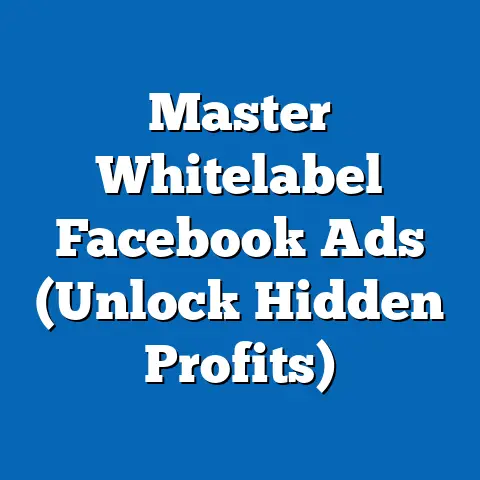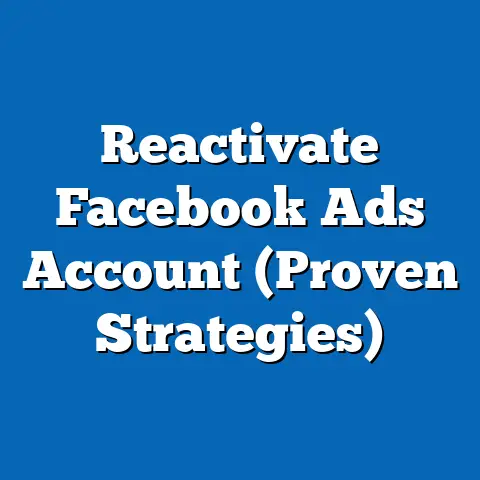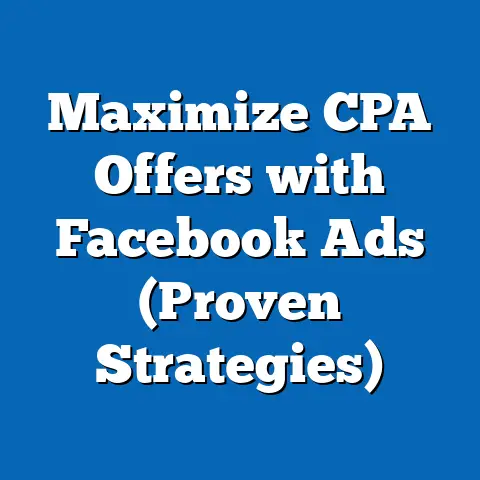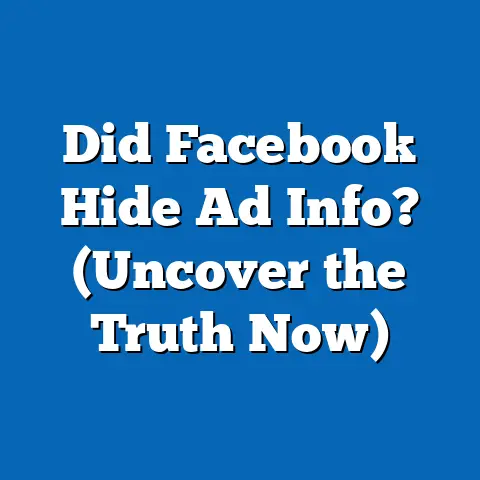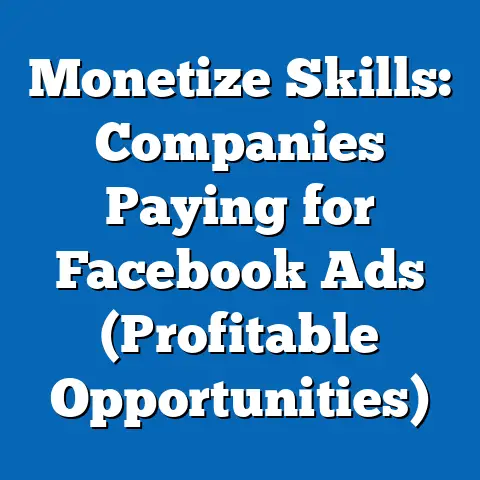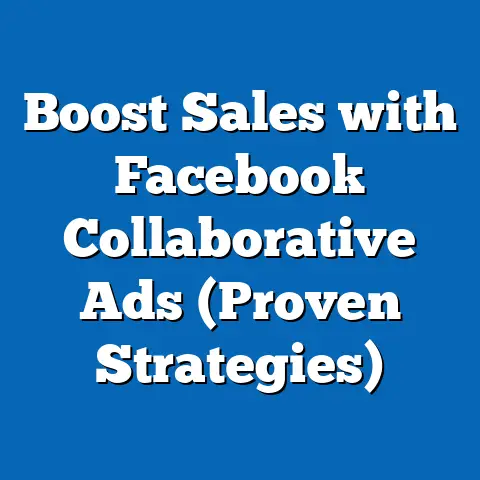Mastering Facebook Ad Troubles (Expert Solutions Inside)
Ever feel like you’re throwing money into a Facebook ad campaign black hole? I get it. I’ve been there. It’s frustrating to see your hard-earned cash disappear with little to no return. You’ve probably heard about the incredible ROI potential of Facebook ads, but instead of a thriving business, you’re staring at low engagement, dismal conversion rates, and a creeping sense of despair. The truth is, mastering Facebook ads isn’t about luck; it’s about understanding the common pitfalls and knowing how to navigate them effectively. Think of it like this: you can’t win a race if you don’t know the track.
But don’t worry, there’s good news! This article is your roadmap to Facebook advertising success. I’m going to share expert solutions that can transform your struggling campaigns into high-performing assets. We’ll dive deep into the common issues advertisers face, equip you with the tools to diagnose your specific problems, and provide proven strategies to overcome them. By the end of this guide, you’ll be well-equipped to turn those ad troubles into triumphs, ultimately boosting your ROI and driving significant business growth. So, let’s get started and unlock the true potential of your Facebook ads!
Understanding Common Facebook Ad Troubles
Facebook advertising, when done right, can be a game-changer. But the path to success isn’t always smooth. I’ve seen countless campaigns stumble because of easily avoidable issues. Knowing what these common problems are is the first step in preventing them from derailing your efforts.
The Most Frequent Issues Advertisers Encounter
Here’s a rundown of the most frequent challenges I’ve observed, along with real-world examples to illustrate their impact:
- Low Engagement Rates: This is where your ads simply aren’t resonating with your target audience. People see your ads, but they don’t click, like, comment, or share. It’s like shouting into a void.
- Example: A local bakery ran an ad showcasing their new cupcake flavors. The image was low-quality, the ad copy was generic (“Try our cupcakes!”), and the targeting was broad (everyone in the city). The result? Minimal clicks and a very low engagement rate.
- Poor Conversion Rates: You’re getting clicks, which is great, but those clicks aren’t turning into sales, leads, or whatever your desired outcome is. This means there’s a disconnect between your ad and your landing page or offer.
- Example: An e-commerce store selling handmade jewelry ran an ad promoting a specific necklace. The ad got a good number of clicks, but the landing page was slow to load, the product description was vague, and the checkout process was clunky. Consequently, the conversion rate was abysmal.
- Ad Fatigue: This happens when your audience gets tired of seeing the same ads over and over again. They start to ignore them, leading to decreased engagement and higher costs.
- Example: A SaaS company launched a new ad campaign promoting their free trial. The ad creative was strong initially, but after a few weeks of running the same ad to the same audience, performance started to decline. Click-through rates plummeted, and the cost per acquisition increased significantly.
- High Costs Per Click (CPC): You’re paying a premium for each click, which eats into your budget and reduces your overall ROI. High CPCs can be caused by various factors, including poor ad relevance, broad targeting, and intense competition.
- Example: A real estate agent ran an ad targeting “anyone interested in buying a house.” The targeting was so broad that they were competing with every other real estate agent in the area, driving up their CPC to an unsustainable level.
- Example: A local bakery ran an ad showcasing their new cupcake flavors. The image was low-quality, the ad copy was generic (“Try our cupcakes!”), and the targeting was broad (everyone in the city). The result? Minimal clicks and a very low engagement rate.
- Example: An e-commerce store selling handmade jewelry ran an ad promoting a specific necklace. The ad got a good number of clicks, but the landing page was slow to load, the product description was vague, and the checkout process was clunky. Consequently, the conversion rate was abysmal.
- Example: A SaaS company launched a new ad campaign promoting their free trial. The ad creative was strong initially, but after a few weeks of running the same ad to the same audience, performance started to decline. Click-through rates plummeted, and the cost per acquisition increased significantly.
- Example: A real estate agent ran an ad targeting “anyone interested in buying a house.” The targeting was so broad that they were competing with every other real estate agent in the area, driving up their CPC to an unsustainable level.
These issues aren’t just minor inconveniences; they can have a significant impact on your overall campaign performance and business objectives. Low engagement means fewer people are seeing your message. Poor conversion rates mean you’re wasting valuable traffic. Ad fatigue means you’re annoying your audience and potentially damaging your brand reputation. And high CPCs mean you’re burning through your budget without getting the results you need.
Takeaway: Recognizing these common pitfalls is the first step towards building successful Facebook ad campaigns. Now, let’s learn how to identify these problems in your own campaigns.
Diagnosing Your Facebook Ad Problems
Okay, so you know the common issues. But how do you know if your ads are suffering from them? The key is to become proficient at analyzing your ad performance using Facebook’s Ads Manager. I’ve spent countless hours poring over these metrics, and I can tell you, they hold the key to unlocking campaign success.
Analyzing Your Ad Performance
Facebook Ads Manager is your control center for understanding how your ads are performing. Here’s a step-by-step guide to analyzing your data and identifying potential problems:
- Access Your Ads Manager: Go to Facebook Ads Manager and select the campaign you want to analyze.
- Customize Your Columns: Click on “Columns” and choose “Customize Columns.” This allows you to select the specific metrics you want to see. I recommend including the following:
- Reach: The number of unique people who saw your ad.
- Impressions: The number of times your ad was displayed.
- Click-Through Rate (CTR): The percentage of people who saw your ad and clicked on it (Clicks / Impressions).
- Cost Per Click (CPC): The average cost you paid for each click.
- Conversions: The number of desired actions taken (e.g., purchases, sign-ups, leads).
- Cost Per Conversion: The average cost you paid for each conversion.
- Relevance Score: Facebook’s assessment of how relevant your ad is to your target audience (this is being phased out, but still useful if you see it).
-
Analyze Your Data: Now, take a close look at your data. Here’s how to interpret some key metrics:
- Low CTR: A CTR below 1% generally indicates that your ad isn’t engaging or relevant to your audience.
- High CPC: A high CPC can indicate that your targeting is too broad, your ad relevance is low, or you’re facing stiff competition. What constitutes a “high” CPC varies by industry, but generally, if it’s significantly higher than your average, it’s a red flag.
- Low Conversion Rate: A low conversion rate (e.g., below 2%) suggests that there’s a problem with your landing page, offer, or targeting.
- High Cost Per Conversion: This indicates that you’re spending too much to acquire each customer or lead.
-
A/B Testing: This is crucial for pinpointing the root causes of ad troubles. Create multiple versions of your ad with slight variations (e.g., different headlines, images, or calls to action). Run these ads simultaneously and track their performance. The winning ad will provide insights into what resonates best with your audience.
- Reach: The number of unique people who saw your ad.
- Impressions: The number of times your ad was displayed.
- Click-Through Rate (CTR): The percentage of people who saw your ad and clicked on it (Clicks / Impressions).
- Cost Per Click (CPC): The average cost you paid for each click.
- Conversions: The number of desired actions taken (e.g., purchases, sign-ups, leads).
- Cost Per Conversion: The average cost you paid for each conversion.
- Relevance Score: Facebook’s assessment of how relevant your ad is to your target audience (this is being phased out, but still useful if you see it).
Analyze Your Data: Now, take a close look at your data. Here’s how to interpret some key metrics:
- Low CTR: A CTR below 1% generally indicates that your ad isn’t engaging or relevant to your audience.
- High CPC: A high CPC can indicate that your targeting is too broad, your ad relevance is low, or you’re facing stiff competition. What constitutes a “high” CPC varies by industry, but generally, if it’s significantly higher than your average, it’s a red flag.
- Low Conversion Rate: A low conversion rate (e.g., below 2%) suggests that there’s a problem with your landing page, offer, or targeting.
- High Cost Per Conversion: This indicates that you’re spending too much to acquire each customer or lead.
A/B Testing: This is crucial for pinpointing the root causes of ad troubles. Create multiple versions of your ad with slight variations (e.g., different headlines, images, or calls to action). Run these ads simultaneously and track their performance. The winning ad will provide insights into what resonates best with your audience.
Example: Let’s say you’re running an ad campaign for a new online course. You notice that your CTR is low (0.5%). This suggests that your ad isn’t engaging your target audience. You decide to A/B test two different headlines:
- Ad A (Original): “Learn Digital Marketing Skills”
- Ad B (New): “Master Digital Marketing in 30 Days”
After running the test for a week, you find that Ad B has a significantly higher CTR (1.8%). This indicates that your audience is more responsive to headlines that promise specific results and a sense of urgency.
Takeaway: Regularly analyzing your ad performance and conducting A/B tests are essential for identifying and diagnosing Facebook ad problems. This data-driven approach will help you make informed decisions and optimize your campaigns for better results. Now, let’s move on to the expert solutions!
Now, let’s tackle them head-on with proven strategies. I’ve spent years honing these techniques, and I’m confident they can help you turn your struggling campaigns around.Proven Strategies to Overcome Ad Troubles
Here’s a breakdown of expert solutions for each of the common issues we discussed earlier:
-
Low Engagement Rates:
- Improve Ad Copy:
- Focus on Benefits, Not Features: Instead of saying “Our product has X feature,” say “Solve Y problem with our product.”
- Use Strong Calls to Action: Tell people exactly what you want them to do (e.g., “Shop Now,” “Learn More,” “Sign Up Today”).
- Ask Questions: Engage your audience by asking questions that relate to their needs and interests.
- Optimize Visuals:
- Use High-Quality Images and Videos: Visuals are the first thing people see. Make sure they’re eye-catching and relevant to your message.
- Test Different Visuals: Experiment with different images, videos, and graphic designs to see what resonates best with your audience.
- Consider User-Generated Content: Authentic content from your customers can be incredibly powerful.
- Target the Right Audience:
- Refine Your Targeting: Use Facebook’s detailed targeting options to narrow down your audience based on demographics, interests, behaviors, and more.
- Create Custom Audiences: Upload your customer list or website visitors to create custom audiences for retargeting.
- Use Lookalike Audiences: Find new customers who are similar to your existing customers by creating lookalike audiences.
- Utilize Video Content:
- Create Short, Engaging Videos: Capture attention quickly with videos that are informative and entertaining.
- Use Captions: Many people watch videos with the sound off, so make sure your videos are understandable with captions.
- Test Different Video Lengths: Experiment with different video lengths to see what performs best for your audience.
- Improve Ad Copy:
-
Poor Conversion Rates:
- Optimize Landing Pages:
- Ensure a Seamless Experience: Make sure your landing page is relevant to your ad and provides a smooth transition for users.
- Improve Page Load Speed: Slow-loading pages can kill conversions. Optimize your images and code to improve load times.
- Use Clear Calls to Action: Make it easy for users to take the desired action by using prominent and persuasive calls to action.
- Use Retargeting Strategies:
- Retarget Website Visitors: Show ads to people who have visited your website but haven’t converted.
- Retarget Abandoned Cart Users: Remind people who added items to their cart but didn’t complete the purchase to come back and finish their order.
- Offer Incentives: Encourage conversions by offering discounts, free shipping, or other incentives to retargeted users.
- Adjust Ad Placements:
- Test Different Placements: Experiment with different ad placements (e.g., Facebook News Feed, Instagram Feed, Audience Network) to see what performs best for your audience.
- Optimize for Mobile: Ensure your ads and landing pages are optimized for mobile devices, as many users access Facebook on their phones.
- Optimize Landing Pages:
-
Ad Fatigue:
- Refresh Ad Creatives:
- Rotate Ads Regularly: Don’t run the same ads for too long. Refresh your ad creatives regularly to keep things fresh.
- Test New Visuals and Copy: Experiment with different visuals and copy to see what resonates with your audience.
- Use Dynamic Ads: Use Facebook’s dynamic ads to automatically show different products or offers to different users based on their interests and behaviors.
- Refresh Ad Creatives:
-
High CPC:
- Optimize Bidding Strategies:
- Use Automated Bidding: Let Facebook’s automated bidding strategies optimize your bids for you.
- Test Manual Bidding: Experiment with manual bidding to see if you can lower your CPC by setting your own bids.
- Monitor Your Bids: Regularly monitor your bids and adjust them as needed to stay competitive.
- Target More Specific Audiences:
- Narrow Down Your Targeting: Use Facebook’s detailed targeting options to narrow down your audience and reach the most relevant users.
- Exclude Irrelevant Audiences: Exclude audiences that are unlikely to convert to avoid wasting your budget.
- Improve Ad Relevance Scores:
- Create Highly Relevant Ads: Make sure your ads are highly relevant to your target audience.
- Use Clear and Concise Messaging: Get straight to the point and tell people what you want them to do.
- Test Different Ad Formats: Experiment with different ad formats (e.g., image ads, video ads, carousel ads) to see what performs best for your audience.
- Optimize Bidding Strategies:
Low Engagement Rates:
- Improve Ad Copy:
- Focus on Benefits, Not Features: Instead of saying “Our product has X feature,” say “Solve Y problem with our product.”
- Use Strong Calls to Action: Tell people exactly what you want them to do (e.g., “Shop Now,” “Learn More,” “Sign Up Today”).
- Ask Questions: Engage your audience by asking questions that relate to their needs and interests.
- Optimize Visuals:
- Use High-Quality Images and Videos: Visuals are the first thing people see. Make sure they’re eye-catching and relevant to your message.
- Test Different Visuals: Experiment with different images, videos, and graphic designs to see what resonates best with your audience.
- Consider User-Generated Content: Authentic content from your customers can be incredibly powerful.
- Target the Right Audience:
- Refine Your Targeting: Use Facebook’s detailed targeting options to narrow down your audience based on demographics, interests, behaviors, and more.
- Create Custom Audiences: Upload your customer list or website visitors to create custom audiences for retargeting.
- Use Lookalike Audiences: Find new customers who are similar to your existing customers by creating lookalike audiences.
- Utilize Video Content:
- Create Short, Engaging Videos: Capture attention quickly with videos that are informative and entertaining.
- Use Captions: Many people watch videos with the sound off, so make sure your videos are understandable with captions.
- Test Different Video Lengths: Experiment with different video lengths to see what performs best for your audience.
- Focus on Benefits, Not Features: Instead of saying “Our product has X feature,” say “Solve Y problem with our product.”
- Use Strong Calls to Action: Tell people exactly what you want them to do (e.g., “Shop Now,” “Learn More,” “Sign Up Today”).
- Ask Questions: Engage your audience by asking questions that relate to their needs and interests.
- Use High-Quality Images and Videos: Visuals are the first thing people see. Make sure they’re eye-catching and relevant to your message.
- Test Different Visuals: Experiment with different images, videos, and graphic designs to see what resonates best with your audience.
- Consider User-Generated Content: Authentic content from your customers can be incredibly powerful.
- Refine Your Targeting: Use Facebook’s detailed targeting options to narrow down your audience based on demographics, interests, behaviors, and more.
- Create Custom Audiences: Upload your customer list or website visitors to create custom audiences for retargeting.
- Use Lookalike Audiences: Find new customers who are similar to your existing customers by creating lookalike audiences.
- Create Short, Engaging Videos: Capture attention quickly with videos that are informative and entertaining.
- Use Captions: Many people watch videos with the sound off, so make sure your videos are understandable with captions.
- Test Different Video Lengths: Experiment with different video lengths to see what performs best for your audience.
Poor Conversion Rates:
- Optimize Landing Pages:
- Ensure a Seamless Experience: Make sure your landing page is relevant to your ad and provides a smooth transition for users.
- Improve Page Load Speed: Slow-loading pages can kill conversions. Optimize your images and code to improve load times.
- Use Clear Calls to Action: Make it easy for users to take the desired action by using prominent and persuasive calls to action.
- Use Retargeting Strategies:
- Retarget Website Visitors: Show ads to people who have visited your website but haven’t converted.
- Retarget Abandoned Cart Users: Remind people who added items to their cart but didn’t complete the purchase to come back and finish their order.
- Offer Incentives: Encourage conversions by offering discounts, free shipping, or other incentives to retargeted users.
- Adjust Ad Placements:
- Test Different Placements: Experiment with different ad placements (e.g., Facebook News Feed, Instagram Feed, Audience Network) to see what performs best for your audience.
- Optimize for Mobile: Ensure your ads and landing pages are optimized for mobile devices, as many users access Facebook on their phones.
- Ensure a Seamless Experience: Make sure your landing page is relevant to your ad and provides a smooth transition for users.
- Improve Page Load Speed: Slow-loading pages can kill conversions. Optimize your images and code to improve load times.
- Use Clear Calls to Action: Make it easy for users to take the desired action by using prominent and persuasive calls to action.
- Retarget Website Visitors: Show ads to people who have visited your website but haven’t converted.
- Retarget Abandoned Cart Users: Remind people who added items to their cart but didn’t complete the purchase to come back and finish their order.
- Offer Incentives: Encourage conversions by offering discounts, free shipping, or other incentives to retargeted users.
- Test Different Placements: Experiment with different ad placements (e.g., Facebook News Feed, Instagram Feed, Audience Network) to see what performs best for your audience.
- Optimize for Mobile: Ensure your ads and landing pages are optimized for mobile devices, as many users access Facebook on their phones.
Ad Fatigue:
- Refresh Ad Creatives:
- Rotate Ads Regularly: Don’t run the same ads for too long. Refresh your ad creatives regularly to keep things fresh.
- Test New Visuals and Copy: Experiment with different visuals and copy to see what resonates with your audience.
- Use Dynamic Ads: Use Facebook’s dynamic ads to automatically show different products or offers to different users based on their interests and behaviors.
- Rotate Ads Regularly: Don’t run the same ads for too long. Refresh your ad creatives regularly to keep things fresh.
- Test New Visuals and Copy: Experiment with different visuals and copy to see what resonates with your audience.
- Use Dynamic Ads: Use Facebook’s dynamic ads to automatically show different products or offers to different users based on their interests and behaviors.
High CPC:
- Optimize Bidding Strategies:
- Use Automated Bidding: Let Facebook’s automated bidding strategies optimize your bids for you.
- Test Manual Bidding: Experiment with manual bidding to see if you can lower your CPC by setting your own bids.
- Monitor Your Bids: Regularly monitor your bids and adjust them as needed to stay competitive.
- Target More Specific Audiences:
- Narrow Down Your Targeting: Use Facebook’s detailed targeting options to narrow down your audience and reach the most relevant users.
- Exclude Irrelevant Audiences: Exclude audiences that are unlikely to convert to avoid wasting your budget.
- Improve Ad Relevance Scores:
- Create Highly Relevant Ads: Make sure your ads are highly relevant to your target audience.
- Use Clear and Concise Messaging: Get straight to the point and tell people what you want them to do.
- Test Different Ad Formats: Experiment with different ad formats (e.g., image ads, video ads, carousel ads) to see what performs best for your audience.
- Use Automated Bidding: Let Facebook’s automated bidding strategies optimize your bids for you.
- Test Manual Bidding: Experiment with manual bidding to see if you can lower your CPC by setting your own bids.
- Monitor Your Bids: Regularly monitor your bids and adjust them as needed to stay competitive.
- Narrow Down Your Targeting: Use Facebook’s detailed targeting options to narrow down your audience and reach the most relevant users.
- Exclude Irrelevant Audiences: Exclude audiences that are unlikely to convert to avoid wasting your budget.
- Create Highly Relevant Ads: Make sure your ads are highly relevant to your target audience.
- Use Clear and Concise Messaging: Get straight to the point and tell people what you want them to do.
- Test Different Ad Formats: Experiment with different ad formats (e.g., image ads, video ads, carousel ads) to see what performs best for your audience.
Example: A local restaurant was struggling with low engagement and high CPCs. They implemented the following solutions:
- Improved Ad Copy: They changed their ad copy to focus on the benefits of dining at their restaurant (e.g., “Enjoy a delicious meal with friends and family”) instead of just listing their menu items.
- Optimized Visuals: They used high-quality photos of their most popular dishes.
- Refined Targeting: They narrowed down their targeting to people who lived within a 5-mile radius of their restaurant and were interested in food and dining.
As a result, their engagement rates increased significantly, and their CPCs decreased dramatically.
Takeaway: By implementing these expert solutions, you can overcome common Facebook ad troubles and improve your campaign performance. Remember to test different strategies and track your results to see what works best for your business.
Advanced Techniques for Mastering Facebook Ads
Now that you’ve tackled the basics, let’s dive into some advanced techniques that can take your Facebook ads to the next level. These strategies are for experienced advertisers who want to maximize their results and stay ahead of the competition.
Taking Your Ads to the Next Level
-
Audience Segmentation:
- Segment Your Audience: Divide your audience into smaller, more specific segments based on demographics, interests, behaviors, and other factors.
- Create Tailored Ads: Create ads that are specifically tailored to each segment.
- Example: A clothing retailer could segment their audience by age, gender, and style preferences. They could then create ads that feature clothing items that are relevant to each segment.
-
Lookalike Audiences:
- Find New Customers: Use lookalike audiences to find new customers who are similar to your existing customers.
- Create High-Quality Seed Audiences: The quality of your lookalike audience depends on the quality of your seed audience. Make sure your seed audience is made up of your best customers.
- Example: A SaaS company could create a lookalike audience based on their existing customers who have a high lifetime value.
-
Custom Audiences:
- Retarget Existing Customers: Use custom audiences to retarget existing customers with relevant offers and promotions.
- Create Engagement-Based Audiences: Create custom audiences based on people who have engaged with your content on Facebook and Instagram.
- Example: An e-commerce store could create a custom audience of people who have visited their website but haven’t made a purchase. They could then retarget these users with ads that offer a discount or free shipping.
-
Facebook Pixel:
- Track Conversions: Use the Facebook Pixel to track conversions on your website and measure the ROI of your ad campaigns.
- Optimize for Conversions: Use conversion tracking to optimize your ad campaigns for better results.
- Create Custom Events: Create custom events to track specific actions on your website, such as adding items to a cart or submitting a form.
-
Integrating Facebook Ads with Other Marketing Channels:
- Create a Cohesive Strategy: Integrate your Facebook ads with your other marketing channels to create a cohesive strategy.
- Use Consistent Messaging: Use consistent messaging across all of your marketing channels to reinforce your brand and message.
- Example: A travel agency could use Facebook ads to drive traffic to their website, where users can book flights and hotels. They could then use email marketing to follow up with users who have booked a trip and offer them additional services, such as travel insurance or tours.
Audience Segmentation:
- Segment Your Audience: Divide your audience into smaller, more specific segments based on demographics, interests, behaviors, and other factors.
- Create Tailored Ads: Create ads that are specifically tailored to each segment.
- Example: A clothing retailer could segment their audience by age, gender, and style preferences. They could then create ads that feature clothing items that are relevant to each segment.
Lookalike Audiences:
- Find New Customers: Use lookalike audiences to find new customers who are similar to your existing customers.
- Create High-Quality Seed Audiences: The quality of your lookalike audience depends on the quality of your seed audience. Make sure your seed audience is made up of your best customers.
- Example: A SaaS company could create a lookalike audience based on their existing customers who have a high lifetime value.
Custom Audiences:
- Retarget Existing Customers: Use custom audiences to retarget existing customers with relevant offers and promotions.
- Create Engagement-Based Audiences: Create custom audiences based on people who have engaged with your content on Facebook and Instagram.
- Example: An e-commerce store could create a custom audience of people who have visited their website but haven’t made a purchase. They could then retarget these users with ads that offer a discount or free shipping.
Facebook Pixel:
- Track Conversions: Use the Facebook Pixel to track conversions on your website and measure the ROI of your ad campaigns.
- Optimize for Conversions: Use conversion tracking to optimize your ad campaigns for better results.
- Create Custom Events: Create custom events to track specific actions on your website, such as adding items to a cart or submitting a form.
Integrating Facebook Ads with Other Marketing Channels:
- Create a Cohesive Strategy: Integrate your Facebook ads with your other marketing channels to create a cohesive strategy.
- Use Consistent Messaging: Use consistent messaging across all of your marketing channels to reinforce your brand and message.
- Example: A travel agency could use Facebook ads to drive traffic to their website, where users can book flights and hotels. They could then use email marketing to follow up with users who have booked a trip and offer them additional services, such as travel insurance or tours.
Takeaway: By mastering these advanced techniques, you can take your Facebook ads to the next level and achieve even greater results. Remember to test different strategies and track your results to see what works best for your business.
Conclusion
Mastering Facebook ads is no longer a luxury; it’s a necessity for achieving business success in today’s digital landscape. I’ve seen firsthand how a well-executed Facebook advertising strategy can transform a struggling business into a thriving one. The key is to understand the common pitfalls, diagnose your specific problems, and implement proven solutions.
I encourage you to take the expert solutions I’ve provided and apply them to your own campaigns. Don’t be afraid to experiment, test different strategies, and track your results. Remember, Facebook advertising is an ongoing process of optimization and refinement. By continuously learning and adapting, you can overcome your ad troubles and achieve your business goals.
You are now equipped with the knowledge and tools to master your Facebook advertising challenges. Go out there, implement these strategies, and watch your campaigns thrive! I believe in you!

